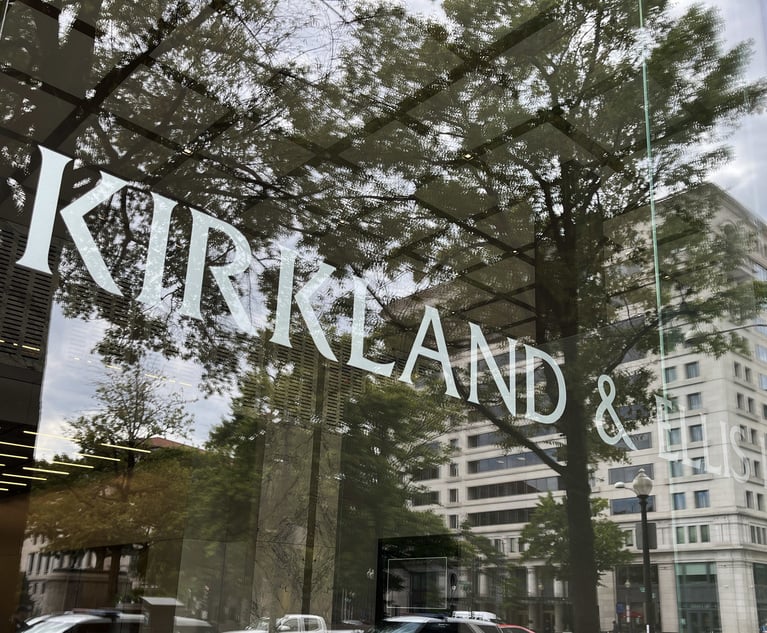Are Law Firm Mergers Hot or Not? It Depends Who's Counting
However they interpret the current volume of deals, observers say law firms are laying the groundwork for a big 2020 for mergers.
October 01, 2019 at 06:18 PM
4 minute read
 Image: Shutterstock
Image: Shutterstock
Confused about the state of the law firm merger market? You're probably not alone.
That's because two legal industry consultancies that track law firm mergers issued very different assessments of merger activity for the third quarter of 2019 this week, with one detailing a slowdown and the other suggesting it was a summer of love for the industry.
Fairfax Associates on Monday said mergers were down compared to 2018, with fewer deals overall, and none of the 46 mergers it has counted so far in 2019 involving large law firms. Altman Weil, meanwhile, reported Tuesday that it had been a "record-shattering" quarter for mergers, with 38 law firms announcing plans to combine, and one deal—Indianapolis-based Taft Stettinius & Hollister linking up with Minneapolis-based Briggs and Morgan—creating a 600-lawyer firm.
The biggest difference between Fairfax and Altman Weil's assessments is spelled out in their releases: Altman Weil counts merger announcements—including those that may not be finalized for months—while Fairfax counts only completed mergers involving firms that have more than five lawyers.
This means deals like the one between Taft and Briggs, announced in August, won't show up in Fairfax's data until 2020, because the merger goes into effect in January 2020.
Not surprisingly, each of the consultancies stands by its own approach. "I think our data is more reflective of what's going on in the marketplace," Altman Weil principal Thomas Clay said.
Clay notes that while Altman Weil includes pending mergers, it requires more than speculation and only counts deals announced by the firms themselves—"all the i's and t's have been dotted and crossed," he said. The firm doesn't count merger talks that spill out into the public but ultimately fail, such as the long-reported negotiations between Allen & Overy and O'Melveny & Myers that collapsed last month.
"Speculation and gossip are of no interest to us," Clay added.
Fairfax analyst Lisa Smith acknowledged that there is difference between the firms' focus, adding that whatever the volume of new deals, there's been a notable lack of "market-shaking mergers" in 2019.
"It's the bigger combinations that drive consolidation," Smith said. "If there were 100 mergers of two-lawyer firms, they wouldn't make much of a difference in the legal market."
Thirteen of the mergers that were announced in Q3 2019 involved firms with four people or less, according to Altman Weil. This included Nixon Peabody acquiring a firm in Washington, D.C., that specialized in immigration issues, and Womble Bond Dickinson merging with an English IP boutique.
However you count them, the year in mergers feels lackluster because 2018 was such a banner year for combinations, said Zeughauser Group consultant Kent Zimmermann. A record-setting 106 law firm merger announcements were made last year, according to Altman Weil, while Fairfax found that 72 mergers were completed, which was higher than 2017′s numbers and the historical average between 2008 and 2017.
The average amount of time that elapses between when merger discussions start and when a deal is closed is nine months, Zimmerman said. And while they may not all be consummated in the end, he said he is engaged in "several active merger discussions" involving Am Law 100, Second Hundred and Global 100 firms.
"Some of those will go the distance," Zimmerman said.
Clay, Smith and Zimmerman each said they're seeing lots of discussions among law firms about merging or acquiring others, and they're all anticipating major law firm merger deals in 2020.
Apart from the upcoming merger of Taft and Briggs, 10 of the announced mergers Altman Weil reported involved global behemoth Dentons adding international offices to its ranks. Dentons' largest announced acquisition in Q3 2019 was Kensington Swan, a 113-lawyer firm in Auckland, New Zealand.
Read More
This content has been archived. It is available through our partners, LexisNexis® and Bloomberg Law.
To view this content, please continue to their sites.
Not a Lexis Subscriber?
Subscribe Now
Not a Bloomberg Law Subscriber?
Subscribe Now
NOT FOR REPRINT
© 2025 ALM Global, LLC, All Rights Reserved. Request academic re-use from www.copyright.com. All other uses, submit a request to [email protected]. For more information visit Asset & Logo Licensing.
You Might Like
View All
Paul Hastings, Recruiting From Davis Polk, Adds Capital Markets Attorney
3 minute read
Kirkland Is Entering a New Market. Will Its Rates Get a Warm Welcome?
5 minute read

Goodwin Procter Relocates to Renewable-Powered Office in San Francisco’s Financial District
Trending Stories
- 15th Circuit Considers Challenge to Louisiana's Ten Commandments Law
- 2Crocs Accused of Padding Revenue With Channel-Stuffing HEYDUDE Shoes
- 3E-discovery Practitioners Are Racing to Adapt to Social Media’s Evolving Landscape
- 4The Law Firm Disrupted: For Office Policies, Big Law Has Its Ear to the Market, Not to Trump
- 5FTC Finalizes Child Online Privacy Rule Updates, But Ferguson Eyes Further Changes
Who Got The Work
J. Brugh Lower of Gibbons has entered an appearance for industrial equipment supplier Devco Corporation in a pending trademark infringement lawsuit. The suit, accusing the defendant of selling knock-off Graco products, was filed Dec. 18 in New Jersey District Court by Rivkin Radler on behalf of Graco Inc. and Graco Minnesota. The case, assigned to U.S. District Judge Zahid N. Quraishi, is 3:24-cv-11294, Graco Inc. et al v. Devco Corporation.
Who Got The Work
Rebecca Maller-Stein and Kent A. Yalowitz of Arnold & Porter Kaye Scholer have entered their appearances for Hanaco Venture Capital and its executives, Lior Prosor and David Frankel, in a pending securities lawsuit. The action, filed on Dec. 24 in New York Southern District Court by Zell, Aron & Co. on behalf of Goldeneye Advisors, accuses the defendants of negligently and fraudulently managing the plaintiff's $1 million investment. The case, assigned to U.S. District Judge Vernon S. Broderick, is 1:24-cv-09918, Goldeneye Advisors, LLC v. Hanaco Venture Capital, Ltd. et al.
Who Got The Work
Attorneys from A&O Shearman has stepped in as defense counsel for Toronto-Dominion Bank and other defendants in a pending securities class action. The suit, filed Dec. 11 in New York Southern District Court by Bleichmar Fonti & Auld, accuses the defendants of concealing the bank's 'pervasive' deficiencies in regards to its compliance with the Bank Secrecy Act and the quality of its anti-money laundering controls. The case, assigned to U.S. District Judge Arun Subramanian, is 1:24-cv-09445, Gonzalez v. The Toronto-Dominion Bank et al.
Who Got The Work
Crown Castle International, a Pennsylvania company providing shared communications infrastructure, has turned to Luke D. Wolf of Gordon Rees Scully Mansukhani to fend off a pending breach-of-contract lawsuit. The court action, filed Nov. 25 in Michigan Eastern District Court by Hooper Hathaway PC on behalf of The Town Residences LLC, accuses Crown Castle of failing to transfer approximately $30,000 in utility payments from T-Mobile in breach of a roof-top lease and assignment agreement. The case, assigned to U.S. District Judge Susan K. Declercq, is 2:24-cv-13131, The Town Residences LLC v. T-Mobile US, Inc. et al.
Who Got The Work
Wilfred P. Coronato and Daniel M. Schwartz of McCarter & English have stepped in as defense counsel to Electrolux Home Products Inc. in a pending product liability lawsuit. The court action, filed Nov. 26 in New York Eastern District Court by Poulos Lopiccolo PC and Nagel Rice LLP on behalf of David Stern, alleges that the defendant's refrigerators’ drawers and shelving repeatedly break and fall apart within months after purchase. The case, assigned to U.S. District Judge Joan M. Azrack, is 2:24-cv-08204, Stern v. Electrolux Home Products, Inc.
Featured Firms
Law Offices of Gary Martin Hays & Associates, P.C.
(470) 294-1674
Law Offices of Mark E. Salomone
(857) 444-6468
Smith & Hassler
(713) 739-1250










